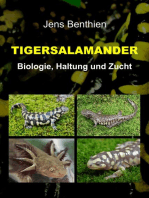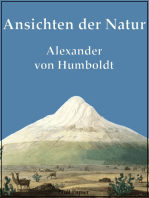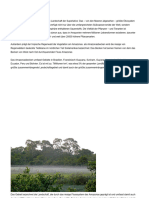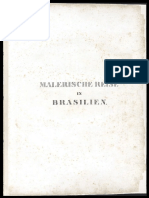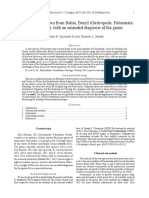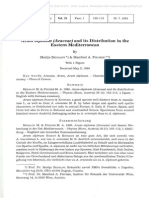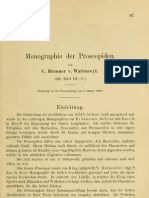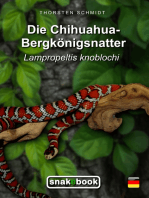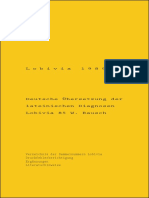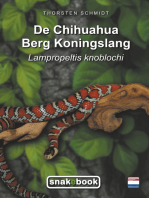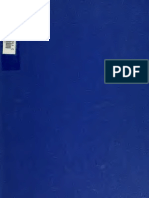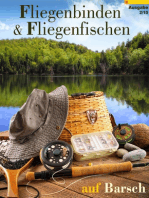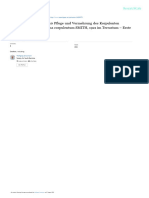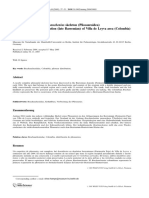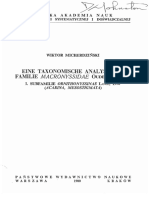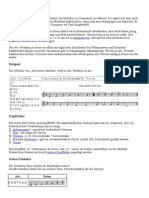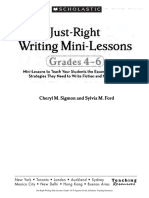Beruflich Dokumente
Kultur Dokumente
Maratecoara Gesmonei
Hochgeladen von
Francisco FalconOriginaltitel
Copyright
Verfügbare Formate
Dieses Dokument teilen
Dokument teilen oder einbetten
Stufen Sie dieses Dokument als nützlich ein?
Sind diese Inhalte unangemessen?
Dieses Dokument meldenCopyright:
Verfügbare Formate
Maratecoara Gesmonei
Hochgeladen von
Francisco FalconCopyright:
Verfügbare Formate
aqua, International Journal of Ichthyology
Description of a new species of annual fish, Maratecoara gesmonei
(Cyprinodontiformes: Rivulidae) from the rio Xingu system,
Amazon basin, Brazil
Dalton Tavares Bressane Nielsen1, Mayler Martins2 and Ricardo Britzke3
1) Laboratório de Zoologia, Departamento de Biologia, Universidade de Taubaté,
Pça Marcelino Monteiro 63, CEP: 12030-010, Taubaté, SP, Brazil. E-mail: dnielsen@uol.com.br
2) Instituto Federal Minas Gerais- Campus Bambuí- Fazenda Varginha-Estrada Bambuí-Medeiros Km 5,
CEP: 38900-000, MG, Brazil. E-mail: maylermarins@yahoo.com.br
3) Universidade Estadual Paulista, Instituto de Biociências, Departamento de Morfologia, Rubião Jr. s/n.
CEP 18618-970. Botucatu, SP, Brazil. E-mail: britzke_r@yahoo.com.br
Received: 13 February 2014 – Accepted: 03 April 2014
Abstract Zusammenfassung
Maratecoara gesmonei n. sp., found on a temporary pool Beschrieben wird hier Maratecoara gesmonei n. sp, deren
at a fluvial island in the middle rio Xingu, Pará State, Vertreter in einem zeitlich begrenzten Tümpel auf einer
Brazil, is described herein. This is the first occurrence of Flussinsel im mittleren Rio Xingu im Bundesstaat Pará in
this genus in the Rio Xingu drainage, Amazon basin. The Brasilien entdeckt wurden. Es handelt sich um den ersten
new species differs from all congeners by its unique color Nachweis dieser Gattung im Einzugsgebiet des Xingu im
pattern which lacks horizontal rows of small dark orange Amazonasbecken, Brasilien. Die neue Art unterscheidet sich
spots on the antero-dorsal portion of the flanks (vs. 2-3 on von allen anderen Angehörigen der Gattung durch das un-
M. lacortei, 3 on M. formosa and M. splendida), or orange verkennbare Farbmuster: die waagerechten Reihen kleiner,
oblique bars on anteroventral portion of trunk (vs. 4-5 or- dunkel orangefarbener Flecken im vorderen Rückenbereich
ange oblique bars on anteroventral portion of trunk in M. der Flanken fehlen hier (im Gegensatz dazu sind bei M. la-
formosa, 3-4 in M. splendida or a broad blotch in M. la- cortei 2-3 Reihen, bei M. formosa und M. splendida 3 Fleck-
cortei). In addition, the new species can be diagnosed from enreihen vorhanden); auch fehlen hier die orangefarbigen
congeners by its lower body depth (23.7-25.9% SL vs. schrägen Streifen im vorderen bauchseitigen Teil des
30.4-40.0% SL), lower caudal peduncle depth (13.0- Rumpfes (bei M. formosa sind 4-5 schräge orangefarbene
15.5% SL vs. 17.1-21.6% SL), and lower number of ver- Streifen vorhanden, bei M. splendida 3-4, bei M. lacortei ein
tebrae, 25-26 (vs. 27-28 in M. lacortei, 26-27 in M. for- breiter Fleck). Weitere Unterscheidungsmerkmale von den
mosa, and 27 in M. splendida). anderen Art der Gattung sind: eine geringere Körpertiefe
(23,7-25,9 % der Standardlänge SL im Gegensatz zu 30,4-
Resumo 40,0% der SL bei den anderen Arten), eine geringere
Maratecoara gesmonei n. sp., encontrada em uma poça tem- Schwanzstieltiefe (13,0-15,5% der SL vs. 17,1-21,6% der
porária em uma ilha fluvial no médio rio Xingu, estado do SL) sowie eine kleinere Wirbelzahl (25-26 im Vergleich zu
Pará, Brasil, é aqui descrita. Esta é a primeira ocorrência do 27-28 bei M. lacortei, 26-27 bei M. formosa und 27 bei M.
gênero na drenagem do Rio Xingu, bacia Amazônica. A no- splendida).
va espécie difere de todas as congêneres pelo padrão único de
cor com ausência de linhas horizontais e pequenas manchas Résumé
laranjas escuras na porção antero-dorsal dos flancos (vs. 2-3 Maratecoara gesmonei n. sp., trouvé dans une mare tem-
na M. lacortei, 3 em M. formosa e M. splendida), ou barras poraire sur une île fluviale du moyen Rio Xingu, état de
oblíquas laranjas (vs. 4-5 barras oblíquas laranja em M. for- Pará, Brésil, est décrit ci-après. C’est la première occur-
mosa, 3-4 em M. splendida ou uma grande mancha em M. rence de ce genre dans le système du Rio Xingu, bassin de
lacortei). Adicionalmente, a nova espécie pode ser diagnosti- l’Amazone. La nouvelle espèce se distingue de tous ses con-
cada de suas congêneres pela menor altura do corpo (23.7- génères par un patron de coloration unique qui ne com-
25.9% SL vs. 30.4-40.0% SL), menor altura pedúnculo prend pas de rangées horizontales de petites taches orange
caudal (13.0-15.5% SL vs. 17.1-21.6% SL) e pelo menor foncé sur la partie antérodorsale des flancs (contre 2-3
número de vértebras, 25-26 (vs. 27-28 em M. lacortei, 26- pour M. lacortei, 3 pour M. formosa et M. splendida) ou des
27 em M. formosa e 27 em M. splendida). barres obliques orange sur la partie antéroventrale du tronc
87 aqua vol. 20 no. 2 - 15 April 2014
Description of a new species of annual fish, Maratecoara gesmonei (Cyprinodontiformes: Rivulidae) from the rio Xingu system, Amazon basin, Brazil
(contre 4-5 barres obliques orange sur la partie antéroven- coara formosa Costa & Brazil, 1995. It originates
trale du tronc pour M. formosa, 3-4 pour M. splendida ou from the city of Brejinho do Nazaré, Tocantins state,
une large tache pour M. lacortei). En outre, la nouvelle and was found in an annual pool in the left bank of
espèce peut être séparée de ses congénères par sa plus faible
hauteur du corps (23,7-25,9 % de LS vs. 30,4-40,0 de LS),
the rio Tocantins. More recently, Costa (2007), de-
une plus faible hauteur du pédoncule caudal (13,0-15,5 % scribed one additional new species, Maratecoara
de LS vs. 17,1-21,6 % de LS) et un nombre inférieur de splendida Costa, 2007, originating from an annual
vertèbres, 25-26 (vs. 27-28 pour M. lacortei 26-27 pour M. pool located close to the rio Canabrava, a tributary
formosa et 27 pour M. splendida). of the left bank of the rio Tocantins.
The genus Maratecoara belongs to the subfamily
Sommario Rivulinae Myers 1925, tribe Rachoviini Costa,
Maratecoara gesmonei n. sp., trovata in una pozza tempo- 1990 and the subtribe Plesiolebiina Costa, 1990.
ranea su un'isola fluviale del medio corso del Rio Xingu, Within the subtribe Plesiolebiina, are also included
Stato di Parà, Brasile, viene qui descritta. Questa è la prima
segnalazione di questo genere nel sistema del Rio Xingu, the genera Plesiolebias Costa 1989, Pituna Costa
bacino idrografico amazzonico. La nuova specie si differen- 1989, Papiliolebias Costa 1998, and Stenolebias
zia da tutte le congeneri per la particolare colorazione Costa 1995a. So far, the genus Maratecoara species
caratterizzata dall’assenza di righe orizzontali di piccole is known exclusively from the rio Tocantins/
macchie di colore arancione scuro sulla porzione antero- Araguaia basin in central Brazil. The new species
dorsale dei fianchi (vs. 2-3 a M. lacortei, 3 su M. formosa e described herein is the first found outside this sys-
M. splendida) o barre oblique arancione sulla parte an- tem, at the middle rio Xingu basin, a the right
teroventrale del tronco (vs. 4-5 barre oblique arancione su bank tributary of the Amazon River. It is also the
parte anteroventrale del tronco in M. formosa e 3-4 in M.
splendida o un’estesa macchia in M. lacortei). Inoltre, la first species described from the Amazon forest do-
nuove specie può essere diagnosticata dalle congeneri per main - the other species are found in the savannah-
una minore altezza del corpo (23.7-25.9% SL vs. 30.4- like Cerrado domain.
40.0% SL), una minore altezza del peduncolo caudale
(13.0-15.5% SL vs. il 17.1-21.6% SL) e un minor numero MATERIAL AND METHODS
di vertebre, 25-26 (vs. 27-28 in M. lacortei, 26-27 in M. Measurements were taken point-to-point under
formosa e 27 in M. splendida). the stereomicroscope with the digital caliper to the
nearest 0.01mm, on the left side of the specimen
INTRODUCTION whenever possible, following Costa (1995b, 2007).
In the middle of the 1980’s, annual fish enthusiasts Measurements are expressed as percentages of stan-
collected three undescribed species of annual fish dard length (SL), except subunits of the head,
from the family Rivulidae in a temporary pool near which are recorded as percentages of head length
the city of Aruanã, located on the right bank of the (HL).
rio Araguaia, Goiás state, Brazil. These three new In the description, counts of vertebrae and pleural
species were then temporarily identified by the codes ribs were taken from cleared and stained (c&s)
GO-1, GO-2, and GO-3. All three species were very specimens, one male and one female paratypes,
beautiful and distinct from what was then known to prepared according to Taylor & Van Dyke (1985).
ichthyologists and aquarists at the time. One of Terminology for frontal squamation follows
them, GO-3, called a great deal of attention because Hoedeman (1958) and Costa (2006). For vertebral
it possessed a metallic blue coloration and long ex- counts the caudal compounded centrum was
tensions on the dorsal and anal fins, recalling anoth- counted as a single element. Osteological features
er species of annual fish, Terranatos dolichopterus included in the description are those considered
Weitzman & Wourms, 1967, from the río Orinoco phylogenetically informative by recent studies on
basin in Venezuela. Not until 1991 were these three Plesiolebiasiina (Costa 2007). Institutional abbre-
species finally described as belonging to the genus viations are LBP (Laboratório de Biologia e
Cynolebias Steindachner, 1876. The species that was Genética de Peixes, Universidade Estadual Paulista,
initially designated with the code GO-3 was de- Botucatu, Brazil), UNITAU (Universidade of
scribed as Cynolebias lacortei (Lazara, 1991). Taubaté, Taubaté, Brazil), and ZUEC (Museu de
Costa (1995a) erected a new genus, Maratecoara, Zoologia da Universidade Estadual de Campinas,
and the species Cynolebias lacortei became the type Campinas, Brazil). Comparisons with congeners
species of this new genus. In the same work, a sec- were based primarily on the literature (Costa,
ond species of Maratecoara was described, Marate- 2007).
aqua vol. 20 no. 2 - 15 April 2014 88
Dalton Tavares Bressane Nielsen, Mayler Martins and Ricardo Britzke
Maratecoara gesmonei, n. sp. mm SL and one female 18.8 mm SL, collected
(Figs 1-2; Table I) with the holotype.
Diagnosis: Males of Maratecoara gesmonei differs
Holotype: ZUEC 7851, male 23.4 mm SL: Brazil, from the remaining congeners by a lower body
Pará state, São Félix do Xingu, temporary pool at depth (23.7-25.9% SL vs. 30.4-40.0% SL); lower
island in the middle of the rio Xingu 06°39’33.3’’ caudal peduncle depth (13.0-15.5% SL vs. 17.1-
S 52°00’21.9’’ W; 17 May 2013, Ricardo Britzke 21.6% SL); lower length of dorsal-fin base (13.5-
& Mayler Martins. 14.5% SL vs. 14.9-19.6% SL); lower length of
Paratypes: LBP 18387, four males, 18.5-20.4 mm anal-fin base (19.7-21.5% SL vs. 20.3-27.2% SL);
SL, six females, 17.9-24.5 mm SL, collected with lower caudal-fin length (34.1-41.4% SL vs. 49.2-
the holotype. ZUEC 7852 (2 c&s), one male 19.6 62.5% SL); lower pelvic-fin length (12.2-14.8%
Fig. 1. Maratecoara gesmonei, ZUEC 7851, holotype, male, 23.4 mm SL. Photo by M. Martins.
Fig. 2. Maratecoara gesmonei, LBP 18387, paratype, female, 24.5 mm SL. Photo by M. Martins.
89 aqua vol. 20 no. 2 - 15 April 2014
Description of a new species of annual fish, Maratecoara gesmonei (Cyprinodontiformes: Rivulidae) from the rio Xingu system, Amazon basin, Brazil
Table I. Morphometric and meristic data for the holotype (H) and paratypes of Maratecoara gesmonei. SD = Standard devi-
ation.
H Paratypes Mean±SD
Male Male n=5 Females n=7
Standard length (mm) 23.4 18.5-20.4 17.9-24.5 19.4±1.53
Percents of SL
Body depth 25.9 23.7-25.9 23.9-25.9 24.9±0.87
Caudal peduncle depth 15.5 13.0-15.5 12.7-12.9 13.8±1.26
Pre-dorsal length 66.8 63.2-67.8 60.1-66.8 65.9±1.82
Pre-pelvic length 51.8 49.5-51.8 52.8-53.2 52.1±1.12
Length of dorsal-fin base 14.5 13.5-14.5 11.3-13.3 13.2±1.17
Length of anal-fin base 19.7 19.7-21.5 15.9-18.1 18.4±2.05
Caudal-fin length 41.4 34.1-41.4 31.9-37.2 36.0±3.17
Pectoral-fin length 23.3 23.3-27.2 19.1-23.8 23.7±2.27
Pelvic-fin length 14.8 12.2-14.8 12.7-14.9 13.5±1.02
Head length 37.3 34.6-37.7 33.6-36.2 35.5±1.47
Percents of HL
Head depth 62.5 62.5-64.6 63.0-64.7 06.7±0.83
Head width 34.7 33.8-35.7 35.3-39.7 63.4±2.37
Lower jaw length 13.8 13.8-15.4 12.8-14.4 14.3±0.67
Eye diameter 31.9 30.8-34.3 30.8-33.3 32.0±1.10
Counts
Dorsal fin 11 11 10
Caudal fin 24 25 24
Anal fin 14 14-15 14
Pelvic fin 7 7 7
Pectoral fin 13 13 13
Meristic
Scales in longitudinal series 25-26 25
Scales in transversal series 8 8
Horizontal scales around caudal peduncle 16 16
SL vs. 15.0-20.0% SL); lower head depth (62.5- and M. splendida); lower number vertebrae, 25-26
64.6% HL vs. 92.2-112.4% HL); lower head (vs. 27-28 in M. lacortei, 26-27 M. formosa, and 27
width (33.8-35.7% HL vs. 54.9-65.8% HL); pec- in M. splendida). Additionally, males of Marate-
toral-fin posterior margin reaching vertical be- coara gesmonei differs from males of the remaining
tween base of the 1st and 2nd anal-fin rays (vs. species of the genus Maratecoara by presenting a
5thand 7th in M. lacortei, 4th and 5th in M. formosa, body color pattern without horizontal rows of
and 4th and 6th in M. splendida); contact organs small dark orange spots on the antero-dorsal por-
absent (vs. 3-5 on posterior margin of each scale on tion of flanks (vs. 2-3 in M. lacortei, 3 in M. for-
ventral portion of flanks in males in M. lacortei, M. mosa and M. splendida), by lacking orange oblique
formosa, and M. splendida); anal-fin origin between bars on anteroventral portion of trunk (vs. 4-5 or-
pleural ribs of 12th and 13th vertebrae (vs.10th and ange oblique bars on anteroventral portion of
11th in M. lacortei and M. formosa, 10th and 12th trunk in M. formosa, and 3-4 in M. splendida, and
in M. splendida); lower number of caudal-fin rays, a broad blotch in M. lacortei), and by presenting
24-25 (vs. 27-30 in M. lacortei, 25-26 M. formosa, overall body coloration with irregular stains of or-
and 25-27 M. splendida); lower number of pelvic- ange and metallic blue (vs. overall body coloration
fin rays, 7 (vs. 8 in M. lacortei, M. formosa, and M. metallic blue with horizontal orange spots in M. la-
splendida); lower number of transverse series of cortei, metallic blue with horizontal and oblique
scales, 8 (vs. 9-10 in M. lacortei, 9 in M. formosa, orange spots in M. formosa and M. splendida).
aqua vol. 20 no. 2 - 15 April 2014 90
Dalton Tavares Bressane Nielsen, Mayler Martins and Ricardo Britzke
Females of Maratecoara gesmonei differ from fe- duncle depth (12.7-12.9% SL vs. 15.1-18.4% SL);
males of remaining species of the genus Marate- lower length of dorsal-fin base (11.3-13.3% SL vs.
coara by presenting a lower body depth (23.9- 13.6-16.5% SL); lower length of anal-fin base
25.9% SL vs. 28.2-34.3% SL); lower caudal pe- (15.9-18.1% SL vs. 19.3-22.2% SL); lower caudal-
Fig. 3. Geographic distribution of the species of the genus Maratecoara.
91 aqua vol. 20 no. 2 - 15 April 2014
Description of a new species of annual fish, Maratecoara gesmonei (Cyprinodontiformes: Rivulidae) from the rio Xingu system, Amazon basin, Brazil
fin length (31.9-37.2% SL vs. 39.6-43.2% SL); slightly pointed in females. Caudal-fin lanceolate in
lower pectoral-fin length (19.1-23.8% SL vs.24.5- males, middle caudal-fin rays filamentous, caudal-
29.7% SL); lower head depth (63.0-64.7% HL vs. fin rounded in females. Pectoral-fin elliptical, distal
78.1-90.1% HL); lower head width (35.3-39.7% margin reaching vertical between base of 1st and 2nd
HL vs. 53.3-61.5% HL); and lower eye diameter anal-fin rays in males, between urogenital papilla
(30.8-33.0% HL vs. 34.4-37.9% HL). and anal-fin origin in females. Pelvic-fin elliptical,
Description: Morphometric data presented in without filaments; tip of each pelvic fin reaching be-
Table I. Largest male examined 23.4 mm SL, largest tween base of 3rd and 4th anal-fin rays in males,
female examined 24.5 mm SL. Dorsal profile slight- reaching to between base of 1st and 2nd anal-fin rays
ly concave between head and base of dorsal-fin, in females. Pelvic-fin bases in close proximity medi-
slightly convex at caudal peduncle. Ventral profile ally. Dorsal fin origin on vertical between base of 3rd
gently convex from lower jaw to end of anal-fin base and 5th anal-fin rays, and between neural spines of
and nearly straight from latter point to caudal pe- 11th and 12th vertebrae in males and 13th and 14tth
duncle. Body moderately slender, greatest body in females. Anal fin origin between pleural ribs of
depth at level of pelvic-fin base. Jaws short, prog- 12th and 13th vertebrae. Dorsal-fin rays 10-11; anal-
nathous, snout slightly pointed. Dorsal fin elongat- fin rays 14-15; caudal-fin rays 24-25; pectoral-fin
ed in males, pointed, rays 7-8 much more elongated rays 13; pelvic-fin rays 7.
than remaining rays, filamentous, tips reaching at Scales cycloid: No scales on caudal, dorsal and anal-
least distal margin of caudal fin when adpressed to fins bases. Frontal squamation F-patterned; E-scales
the body; anal fin pointed in males, pointed, rays 7- not overlapping medially; scales arranged in regular
8 much more elongated than remaining rays, fila- transverse pattern. Longitudinal series of scales 25-
mentous, tips reaching distal margin of caudal fin 26; transverse series of scales 8; scale rows around
when adpressed to body; dorsal and anal fins just caudal-fin peduncle 16. Contact organs absent.
Fig. 4. Type locality of Maratecoara gesmonei, pool at island at the middle of the Rio Xingu, in front of São Félix does Xingu,
Pará, Brazil. Photo by M. Martins.
aqua vol. 20 no. 2 - 15 April 2014 92
Dalton Tavares Bressane Nielsen, Mayler Martins and Ricardo Britzke
Fig. 5. Physical map of eastern South America, showing the Araguaia-Tocantins depression and the Transbrasiliano Linea-
ment.
93 aqua vol. 20 no. 2 - 15 April 2014
Description of a new species of annual fish, Maratecoara gesmonei (Cyprinodontiformes: Rivulidae) from the rio Xingu system, Amazon basin, Brazil
Fig. 6. Geographic distribution of the genera Pituna and Plesiolebias.
aqua vol. 20 no. 2 - 15 April 2014 94
AQUA20(2)-LAYOUT.qxp_AQUA 18/04/14 13:37 Pagina 95
Dalton Tavares Bressane Nielsen, Mayler Martins and Ricardo Britzke
Cephalic neuromasts: supraorbital 6+3, parietal 3, Thayeria boehlkei; Serrassalmus sp., and Hoplias
anterior rostral 1, posterior rostral 1, infraorbital 1 + malabaricus. Other aquatic animals recorded at the
25, preorbital 4, otic 1, post-otic 2, supratemporal 1, site were tadpoles and freshwater crabs. Aquatic
median opercular 1, ventral opercular 1, preopercu- vegetation was not present and the bottom was
lar 14, mandibular 8, lateral mandibular 5.Two neu- composed of clay, leaves, sand and mud. Marate-
romasts on fin base. Total vertebrae 25-26. coara gesmonei was always found in areas close the
C o l o r a t i o n i n l i f e (Figs 1-2). Males: Sides margin of the pool, nearby submerged trunks, at
of body metallic blue and orange with irregular col- about 50 cm depth, while Pituna xinguensis was
or distribution, without bars or lines, dorsally or- found in more shallow areas (about 5 cm deep) and
ange. Abdominal region clear. Sides of head metal- Plesiolebias altamira in deeper areas (about 1 meter
lic blue and orange. Jaws orange. Iris bright green; deep).
a black bar vertically crossing the eye. Dorsal-fin or- Etymology: The specific name gesmonei is treated
ange with metallic blue blotches. Anal-fin metallic as a patronym in gratitude and recognition to Ges-
blue with slightly orange stains. Caudal-fin orange mone Fernandes Godoy, who discovered the
with metallic blue spots. Pectoral-fins hyaline. species.
Pelvic-fins metallic blue with an orange spot.
Females: Overall color light brownish gray, with DISCUSSION
longitudinal rows of pale brown dots on the sides The genus Maratecoara is defined by the follow-
of body. Abdominal region clear. Sides of head and ing synapomorphies: long dorsal and anal fins with
jaws gray, with a pale greenish yellow hue. Iris yel- tips extending beyond the posterior margin of cau-
low, with a dark gray vertical bar through center of dal-fin; caudal-fin lanceolate, tip with two or three
eye. Fins hyaline. filamentous rays; long opercular membranes with
Distribution: Currently only known from the blue iridescence, extending on to the anterior por-
type-locality, a temporary pool at an island from tion of pectoral-fin; and flanks metallic blue with
middle rio Xingu, Amazon basin, Pará state, Brazil orangish golden spots (Costa, 2007).
(Fig. 3). The discovery of annual pools in São Félix do
Habitat (Fig. 4): The type-locality lies in a Xingu increases the knowledge of distribution of
plateau area of Brazil (198 m a.s.l.), on an island in annual fishes in the rio Xingu basin, which were so
the middle of the rio Xingu, in front of the city of far only known to the neighborhoods of Altamira,
São Félix do Xingu. The island has a total area of where the Belo Monte dam is currently being
about 465m2 and a perimeter of about 3.160 km.It build. The building of this dam will probably de-
lies about 330 m from the left bank of the river and stroy the known habitat of the annual fishes that
about 540 m from the right bank. The annual pool were so far known from the rio Xingu basin, i.e.,
is very large with most of its area within a dense Spectrolebias reticulatus, Plesiolebias altamira, Pitu-
forest. Water temperature, at the depth of 25 cm na xinguensis and Rivulus xinguensis. Fortunately,
was 26.5°C, whereas at the marginal area of the Pituna xinguensis and Plesiolebias altamira were
pool, at the depth of 5 cm, was 27.5°C. The aver- found occurring syntopically with Maratecoara ges-
age depth of the pool was 0.5 m, with the deepest monei, and consequently will not be extirpated by
portions about 1.20 m. Water color was dark and the building of the Belo Monte dam. São Felix do
acidic, with pH 5.5. Other physic-chemical para- Xingu is about 384 km in a straight line from Al-
meters were: electric conductibility 8 µS, total tamira, and very likely, more habitats for annual
hardness (GH) 0°dGH, carbonate hardness (KH) fishes exist in the intervening area.
0°dGH, dissolved iron (Fe) 0.5 mg/l, dissolved cal- The type locality of Maratecoara gesmonei is con-
cium (Ca) 0 mg/l, dissolved copper (Cu) 0 mg/l, siderably distant from the other known localities of
dissolved phosphate (PO4) 0.1 mg/l, and ammoni- Maratecoara species, i.e., 932 km from the type-lo-
um/ammonia (NH3/NH4) 0 mg/l. cality of M. lacortei, 815 km from the type-locality
Other annual fish species collected syntopically of M. splendida and 640 km from the type-locality
were Pituna xinguensis and Plesiolebias altamira. of M. formosa (Fig. 3). All Maratecoara species are
The pool was beginning to dry up and the collec- only known from their type localities locations,
tors also found juveniles of the following characi- with the exception for M. lacortei, which is known
form fish species living syntopically: Moenkhausia from several sites at the rio Araguaia at the city of
xinguensis, M. ceros, Jupiaba sp., Hyphessobrycon sp., Aruanã and its tributary, the rio das Mortes, and
95 aqua vol. 20 no. 2 - 15 April 2014
Description of a new species of annual fish, Maratecoara gesmonei (Cyprinodontiformes: Rivulidae) from the rio Xingu system, Amazon basin, Brazil
downstream into the Ilha do Bananal. Although and Itamar Alves Martins from Universidade de
the genus probably has a natural patchy distribu- Taubaté (UNITAU) for laboratory support; Dr.
tion, this disjunctness may be a sampling artifact, Roger David Brousseau who reviewed the English
both due to the relatively little fieldwork directed version and Flávio C. T. Lima (ZUEC) for reading
to the search of annual fishes, and also due to a the manuscript and for offering useful suggestions.
possible great contraction of available habitat for
the species of the genus and for annual fishes as a
REFERENCES
whole caused by the massive destruction of the COSTA, W. J. E. M. 1995a. Two new genera and two new
Cerrado vegetation domain in Central Brazil, species of the neotropical annual fishes Plesiolebiasini
which is being replaced by large monoculture plan- (Cyprinodontiformes: Rivulidae), with studies on the re-
tations. lationships of the tribe. Revue Française d’Aquariologie et
The occurrence of the new species Maratecoara Herpetologie 21: 65-74.
gesmonei in the rio Xingu basin might be associated COSTA, W. J. E. M. 1995b. Pearl killifishes - the Cynolebi-
to the neotectonic activity across the Transbrasil- atinae: systematics and biogeography of the neotropical an-
iano Lineament area, a mega linear structure with nual fish subfamily. TFH, Neptune City, 128 pp.
COSTA, W. J. E. M. 2006. Descriptive morphology and
about 2700 km, which begins in upper Paraguay phylogenetic relationship among species of the Neotrop-
River, crossing the Brazilian Shield to the northeast ical annual killifish genera Nematolebias and Simp-
coast of Brazil, which also is hypothesized as the sonichthys (Cyprinodontiformes: Aplocheiloidei: Rivuli-
geological drive behind current ranges of other fish dae). Neotropical Ichthyology 4: 1-26.
taxa occurring across shield-draining river basins of COSTA, W. J. E. M. 2007. Taxonomy of the Plesiolebiasine
Central Brazil (Lima & Ribeiro 2011) (Fig. 5). killifish genera Pituna, Plesiolebias and Maratecoara
These authors reported that the distribution of sev- (Teleostei: Cyprinodontiformes: Rivulidae), with de-
eral fish taxa was probably shaped by several head- scriptions of nine new species. Zootaxa 1410: 1-41.
LAZARA, K. J. 1991. Cynolebias lacortei, Cynolebias costai,
waters captures generated by neotectonic activity and Cynolebias aruana: three new species of cloud fish
between the Pantanal depression and Araguaia-To- from Brazil (Teleostei, Cyprinodontiformes, Rivulidae).
cantins depression, which probably allowed a inter- Journal of the American Killifish Association 23: 139-152.
change of fish populations among distinct river HOEDEMAN, J. J. 1958. The frontal scalation pattern in
basins. Other genera of the subtribe Plesiolebiina, some groups of tooth carps. Bulletin of Aquatic Biology 1:
like Plesiolebias and Pituna, possess a similar distri- 23-28.
bution along the Transbrasilian Lineament and LIMA, F. C. T. & A. RIBEIRO, C. 2011. Continental-scale
they also occur in the middle and lower rio Xingu tectonic controls of biogeography and ecology. Pp. 145-
164. In: Albert, J. S. & R. E. Reis (Eds.). Historical Bio-
region (Fig. 6). geography of Neotropical Freshwater Fishes. Berkeley: Uni-
versity of California Press.
ACKNOWLEDGEMENTS TAYLOR, W. R. & VAN DYKE, G. C. 1985. Revised proce-
We are grateful to Flávio C. T. Lima (ZUEC) and dures for staining and clearing small fishes and other ver-
Claudio Oliveira (LBP) for curatorial assistance tebrates for bone and cartilage study. Cybium 9: 107-119.
aqua vol. 20 no. 2 - 15 April 2014 96
Das könnte Ihnen auch gefallen
- Faszination Amazonas: Seine Menschen, seine Tiere, seine PflanzenVon EverandFaszination Amazonas: Seine Menschen, seine Tiere, seine PflanzenNoch keine Bewertungen
- Schmidt 2005 Tar 110 3 49Dokument47 SeitenSchmidt 2005 Tar 110 3 49Ferenc TörökNoch keine Bewertungen
- Ansichten der Natur - Die Vermessung Südamerikas: Der KlassikerVon EverandAnsichten der Natur - Die Vermessung Südamerikas: Der KlassikerNoch keine Bewertungen
- StiasnyDokument10 SeitenStiasnyLibertine Agatha DensingNoch keine Bewertungen
- Haft Franzen 1996 Schistometopum ThomenseDokument7 SeitenHaft Franzen 1996 Schistometopum ThomensejlkljhlkNoch keine Bewertungen
- Two New Ammonite Genera From The Lower Turonian of Venezuela. Renz and Galea-Alvarez.Dokument9 SeitenTwo New Ammonite Genera From The Lower Turonian of Venezuela. Renz and Galea-Alvarez.Francia Galea AlvarezNoch keine Bewertungen
- Ü3 BrasilienDokument4 SeitenÜ3 BrasilienMoodM8Noch keine Bewertungen
- Rugendas Viagem Pitoresca Através Do Brasil PDFDokument275 SeitenRugendas Viagem Pitoresca Através Do Brasil PDFriblopesNoch keine Bewertungen
- Allgemeine Süßwasserkrebspraxis: Flusskrebse, Garnelen, Krabben, Mittelkrebse & Pfeilschwanzkrebse des Süß- und BrackwassersVon EverandAllgemeine Süßwasserkrebspraxis: Flusskrebse, Garnelen, Krabben, Mittelkrebse & Pfeilschwanzkrebse des Süß- und BrackwassersNoch keine Bewertungen
- A New Species of Kora From Bahia BrazilDokument7 SeitenA New Species of Kora From Bahia BrazilMarc AlexandreNoch keine Bewertungen
- Arum AlpinumDokument11 SeitenArum AlpinumGürol AytepeNoch keine Bewertungen
- Geophagus MegasemaDokument10 SeitenGeophagus MegasemaBAGADOU100% (3)
- Verhandlungender 40 ZoolDokument548 SeitenVerhandlungender 40 ZoolFilippo Maria BuzzettiNoch keine Bewertungen
- Bremer 2005 Amarygmus XXXVI Neu Guinea Aus Dem Naturkundemus ErfurtDokument5 SeitenBremer 2005 Amarygmus XXXVI Neu Guinea Aus Dem Naturkundemus ErfurtDávid RédeiNoch keine Bewertungen
- Z-Mykologie 65 1999 0033-0039Dokument9 SeitenZ-Mykologie 65 1999 0033-0039Augusto CalzadaNoch keine Bewertungen
- Chornogubsky 2011 - Leonardus CuspidatusDokument8 SeitenChornogubsky 2011 - Leonardus CuspidatusLauraNoch keine Bewertungen
- Schumacher 1915 Sauters FormosaAusbeute HomopteraDokument35 SeitenSchumacher 1915 Sauters FormosaAusbeute HomopteraDávid RédeiNoch keine Bewertungen
- Brehms Tierleben. Band 26. Ergänzungsband 2: Käfer IIVon EverandBrehms Tierleben. Band 26. Ergänzungsband 2: Käfer IINoch keine Bewertungen
- Nordsieck - Murellen 2011 Kopie PDFDokument11 SeitenNordsieck - Murellen 2011 Kopie PDFCharles Geerts100% (1)
- Reise in die Aequinoctial-Gegenden des neuen Continents. Band 3.Von EverandReise in die Aequinoctial-Gegenden des neuen Continents. Band 3.Noch keine Bewertungen
- Les Trilobites Asteropyginae Du Dévonien de l'Anti-Atlas - Morzadec 2001Dokument49 SeitenLes Trilobites Asteropyginae Du Dévonien de l'Anti-Atlas - Morzadec 2001Le van anNoch keine Bewertungen
- Die Chihuahua-Bergkönigsnatter: Lampropeltis knoblochiVon EverandDie Chihuahua-Bergkönigsnatter: Lampropeltis knoblochiNoch keine Bewertungen
- Wahl R. - Lobivia 1989 (немецкий, 1989) PDFDokument45 SeitenWahl R. - Lobivia 1989 (немецкий, 1989) PDFFernandoNoch keine Bewertungen
- Bibliotheca Botanica Haplopappus ParteaDokument70 SeitenBibliotheca Botanica Haplopappus Parteapupi.puduNoch keine Bewertungen
- Bremer 2005 Amarygmus XXXV Bunamarygmus Javanus SP NDokument5 SeitenBremer 2005 Amarygmus XXXV Bunamarygmus Javanus SP NDávid RédeiNoch keine Bewertungen
- Spaeth 1935 CassidinaeDokument6 SeitenSpaeth 1935 CassidinaeDávid RédeiNoch keine Bewertungen
- Distribution and Conservation Status of Bothrops Asper (GARMAN, 1884) in Ecuador (Squamata: Serpentes: Viperidae: Crotalinae)Dokument7 SeitenDistribution and Conservation Status of Bothrops Asper (GARMAN, 1884) in Ecuador (Squamata: Serpentes: Viperidae: Crotalinae)OreomanesNoch keine Bewertungen
- Bremer 2004 Amarygmus XXVII Amarygmus Mayri Spec NovDokument6 SeitenBremer 2004 Amarygmus XXVII Amarygmus Mayri Spec NovDávid RédeiNoch keine Bewertungen
- Morphological Responses of Cave Bears UrDokument14 SeitenMorphological Responses of Cave Bears UrGianfranco BongioanniNoch keine Bewertungen
- Glosario Terminológico Geología Alemán-EspañolDokument31 SeitenGlosario Terminológico Geología Alemán-EspañolKevin Fabian Astudillo ValenzuelaNoch keine Bewertungen
- De Chihuahua Berg Koningslang: Lampropeltis knoblochiVon EverandDe Chihuahua Berg Koningslang: Lampropeltis knoblochiNoch keine Bewertungen
- Hildebrand Husser & Rast 2020 Ara 25 22 38Dokument17 SeitenHildebrand Husser & Rast 2020 Ara 25 22 38Moisés Benites DíazNoch keine Bewertungen
- Egh-001 1995 88 1023 DDokument25 SeitenEgh-001 1995 88 1023 Dguytanoh690Noch keine Bewertungen
- Sanatkumaracaritam JacobiDokument210 SeitenSanatkumaracaritam JacobiАртем ТрофимовNoch keine Bewertungen
- Late Pleistocene Stegomastodon MammaliaDokument22 SeitenLate Pleistocene Stegomastodon MammaliaLeon Felipe ChaparroNoch keine Bewertungen
- Atlas of The Amphibians and Reptiles ofDokument16 SeitenAtlas of The Amphibians and Reptiles ofDaniel GhiurcaNoch keine Bewertungen
- Specieshepaticarum Vol 1 AnacroginasDokument438 SeitenSpecieshepaticarum Vol 1 AnacroginasJose Facundo Ortega OrizNoch keine Bewertungen
- BF 00446Dokument12 SeitenBF 00446Neo StralizNoch keine Bewertungen
- VZBG 156 0099-0113Dokument17 SeitenVZBG 156 0099-0113Thuy Nguyen Thi NgocNoch keine Bewertungen
- Hölzer 2017Dokument8 SeitenHölzer 2017aa.hoelzerNoch keine Bewertungen
- Aussaat - Und Kulturhinweise Makaronesische Echium ArtenDokument5 SeitenAussaat - Und Kulturhinweise Makaronesische Echium Artentbib2004-stuffNoch keine Bewertungen
- SC061 Rudzinski 1988Dokument5 SeitenSC061 Rudzinski 1988el ouazzani nour el houdaNoch keine Bewertungen
- 10.1007 bf02593670Dokument35 Seiten10.1007 bf02593670RoxanaNoch keine Bewertungen
- Der Bandeirante Antônio Raposo Tavares: 10.000 Kilometer durch Brasilien – Eine (fast) wahre GeschichteVon EverandDer Bandeirante Antônio Raposo Tavares: 10.000 Kilometer durch Brasilien – Eine (fast) wahre GeschichteNoch keine Bewertungen
- Atala und René: Die Geschichte einer unmöglichen Liebe - Klassiker der französischen RomantikVon EverandAtala und René: Die Geschichte einer unmöglichen Liebe - Klassiker der französischen RomantikNoch keine Bewertungen
- Blau (1998) Ammoniten LienzDokument109 SeitenBlau (1998) Ammoniten LienzgabrielNoch keine Bewertungen
- Grossmann Harbig 2010 LygosomacorpulentumDokument25 SeitenGrossmann Harbig 2010 LygosomacorpulentumnuoikienvnNoch keine Bewertungen
- 114 - Avicularia Aurantiaca, Bauer 1996Dokument8 Seiten114 - Avicularia Aurantiaca, Bauer 1996VulpesNoch keine Bewertungen
- Calculus For Ap 2Nd Edition Larson Full ChapterDokument67 SeitenCalculus For Ap 2Nd Edition Larson Full Chaptercarla.campbell348100% (4)
- Zawodny 1897 Eine Botanische Reise Durch Die Herzegovina. - Deutsche Botanische Monatsschrift 15 266-270.Dokument5 SeitenZawodny 1897 Eine Botanische Reise Durch Die Herzegovina. - Deutsche Botanische Monatsschrift 15 266-270.Semir MasloNoch keine Bewertungen
- Considerations On A Brachauchenius Skeleton (Pliosauroidea) From The Lower Paja Formation (Late Barremian) of Villa de Leyva Area (Colombia) PDFDokument15 SeitenConsiderations On A Brachauchenius Skeleton (Pliosauroidea) From The Lower Paja Formation (Late Barremian) of Villa de Leyva Area (Colombia) PDFSebàstian LopezNoch keine Bewertungen
- Hartmann-Schroder. 1962a. Zweiter Beitrag Zur Polychaetenfauna Von PeruDokument59 SeitenHartmann-Schroder. 1962a. Zweiter Beitrag Zur Polychaetenfauna Von PeruAndrew AlvaradoNoch keine Bewertungen
- Micherdzinski 1980 - OrithonyssinaeDokument132 SeitenMicherdzinski 1980 - OrithonyssinaeMichelNoch keine Bewertungen
- Region AmazonicaDokument22 SeitenRegion AmazonicaTopo Bass CorleoneNoch keine Bewertungen
- Aussichten A1 KB Probelektion1Dokument20 SeitenAussichten A1 KB Probelektion1Ivanka ShtyfanenkoNoch keine Bewertungen
- Hausaufgabe Traumnovelle PDFDokument4 SeitenHausaufgabe Traumnovelle PDFAndreea LupuNoch keine Bewertungen
- ABC Notation Teil1Dokument6 SeitenABC Notation Teil1gymimusikNoch keine Bewertungen
- Just-Right Writing Mini Lessons - GR 4 To 6 PDFDokument128 SeitenJust-Right Writing Mini Lessons - GR 4 To 6 PDFTO Chau100% (1)
- Zweifelfaelle Maß - Und MengenangabenDokument17 SeitenZweifelfaelle Maß - Und MengenangabentetianamolnarNoch keine Bewertungen
- Grade 8 German NotesDokument13 SeitenGrade 8 German NotesWee Too LoNoch keine Bewertungen
- C Informatik Und C Skript Release 2 4 IOEDokument147 SeitenC Informatik Und C Skript Release 2 4 IOEHermann MayrNoch keine Bewertungen
- Elke Oertgen (Erde)Dokument2 SeitenElke Oertgen (Erde)Kenan YazıcılarNoch keine Bewertungen
- Adjektivdeklination Nach Dem Bestimmten ArtikelDokument2 SeitenAdjektivdeklination Nach Dem Bestimmten ArtikelМазун Дарина ОлександрівнаNoch keine Bewertungen
- Notice Installaton Ecodan Hydrobox Duo Split Zubadan Mitsubishi ElectricDokument44 SeitenNotice Installaton Ecodan Hydrobox Duo Split Zubadan Mitsubishi Electricjulien cambinNoch keine Bewertungen
- Homer WoerterbuchDokument634 SeitenHomer WoerterbuchIvan Babitski100% (2)
- Samuel WatersDokument150 SeitenSamuel Watersdagon8Noch keine Bewertungen
- Abenteuer Im Schnee - Andrea Maria WagnerDokument52 SeitenAbenteuer Im Schnee - Andrea Maria WagnerMilva0% (1)
- Deutche VerbenDokument5 SeitenDeutche VerbenAstrit E. SalihuNoch keine Bewertungen
- Der Genitiv B1Dokument4 SeitenDer Genitiv B1Ramon LamasNoch keine Bewertungen


